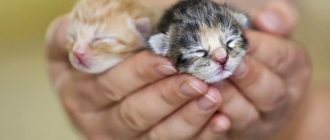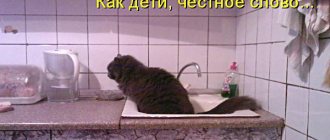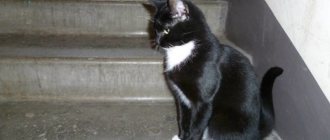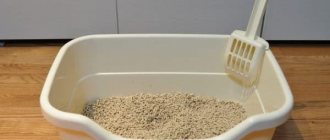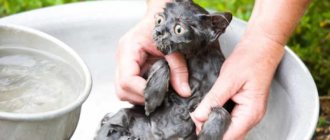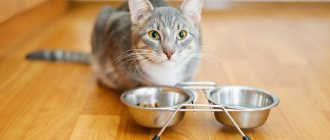Agree that when a pet lives in the house, life takes on more bright colors and becomes more interesting. After all, “our smaller friends” surprise with their behavior, amuse and touch. I would especially like to mention cats, which not only cleanse the apartment of negative energy, but are also able to cure their owners of many ailments. And how nice it is in the evening, after a hard day at work, to retire with your favorite pet and listen to its purring, which acts on the nervous system no worse than an antidepressant. However, before you get a furry pet, you need to create comfortable living conditions for it. We will tell you further about how to keep a cat in an apartment.
What to feed your cat?
When a cat appears in the house, the first question that arises is what to feed the animal? Pet stores have a huge selection of different cat foods, but you can also feed your pet natural food: boiled meat or fish, some vegetables, dairy products, rice and buckwheat. If your choice falls on factory-made food, then you should take into account the age, sterilization of the animal, the activity of the “fluffy” and the presence of certain diseases. For each individual case, you can choose the appropriate food.
Bowls and food
A supply of high-quality food from the “For the Little Ones” lines and three bowls is what a small kitten needs in the first days of his stay in the house. If you can do without toys and shampoo for some time, then food is needed immediately. Tips for choosing it:
- When buying a kitten from a nursery, you should check with the breeder what brand the baby consumed and buy that one. In the future, if the owner wishes, it will be possible to switch the pet to natural food, for example, chicken, whole grains, with the addition of vegetables and fruits;
- fresh, clean water should be available at all times;
- It is not recommended to buy cheap economy-class food; for the health of the kitten, it is important to provide it with products of at least super premium class.
It is important to choose quality bowls. Cheap plastic models are certainly beautiful, often decorated with cat faces. But they have a specific smell and release formaldehyde into the air, so they are dangerous not only for the pet, but also for the owner. Choose ceramic or metal. The first ones are environmentally friendly, but your pet can accidentally break them and get hurt.
Note! Metal bowls are durable, but if the material is not coated with a protective coating, they can become rusty.
Source
The appearance of a kitten in the house: what to prepare for its comfortable placement, what points to consider when planning to get a cat? How to help a small pet get comfortable in a new home?
What vitamins and vaccinations do cats need?
Cats that live permanently in an apartment need vitamin supplements, which can be purchased at veterinary pharmacies. You can also plant special grass for cats on the windowsill, which they will enjoy feasting on and saturate the body with essential vitamins. And do not forget to regularly visit the veterinarian, who will vaccinate the animal against rabies and viruses.
Nutrition for pregnant and lactating cats
In order for cats to feel good during pregnancy and not have any health problems, special attention should be paid to their nutrition. The menu should be balanced, it should contain all the necessary vitamins and substances to strengthen the immune system.
Dietary recommendations for a pregnant cat:
- You shouldn’t suddenly change your diet; your pet can be given the same foods and feeds that she was used to eating before pregnancy;
- Additionally, you can include food specifically for pregnant cats;
- Veterinarians do not advise giving fish to animals when carrying kittens. But if your pet demands fish, then you can give her a small piece, but only boiled;
- from natural products you can use veal, chicken, broth, some boiled eggs, dairy products (kefir, natural yogurt, cottage cheese), cereals, boiled vegetables;
- Additionally, you can give vitamins for pregnant cats.
Toilet issue
As a rule, the cat chooses a latrine for itself, where it can later be placed with a litter tray. The tray should have low edges, into which a special filler is placed (with the smell of wood, sand, etc.). For adult cats, a tray with high sides is suitable so that the contents do not scatter around the apartment.
What you need to know about pet rules
Many people have animals at home. But before you get a pet, you need to know:
- how to properly maintain it;
— what payments will need to be made;
- what is the responsibility and what can happen and much more.
Let's consider these and other points in more detail.
What to do after getting a pet
So, you got a pet and have even thought of a name for it. What needs to be done next?
First of all, the animal must be registered . This can be done at the housing department or at the owners' association (for rural areas - at the village executive committee) at the place of residence by writing an application. In addition to the application, you will also need to present an identity document <*>. This procedure is free and is completed on the day the application is submitted. As a result, you will receive an indefinitely valid certificate and tag for your pet. The tag must be permanently attached to the animal's collar <*>.
Note! Only cats and dogs . Moreover <*>: - these animals are subject to registration within 3 days from the date of purchase ; - puppies and kittens must be registered at the age of 3 to 3.5 months.
Next, you must notify the veterinary institution at your place of permanent residence about the purchase of a pet. This must be done within 3 days after adopting the animal <*>.
For information, the Veterinary Institution must also be notified of the sale, death, loss, change of residence or surrender of a dog or cat.
If the animal has already reached the age of three months, it must be vaccinated against rabies. This vaccination must be done annually <*>.
Note! Not only cat and dog owners should have their pets vaccinated against rabies. This rule applies to all carnivorous animals that have owners <*>.
If you live in a private house <*> or in an apartment in a blocked residential building <*>, then you must build an enclosure(s) for animals (if they are kept on the street), and also ensure that the surrounding area is fenced with a height of at least 1. 7 m (in case of walking animals) <*>.
What rules must be followed
As strange as it may sound, your animals are your property <*>, and as a general rule, you bear the burden of maintaining such property <*>. Let's look at some of the requirements that you must comply with as the owner of such a specific property.
In one apartment of a multi-apartment residential building <*> you can keep no more than two animals (dogs, cats). If several tenants (owners) live in an apartment, it is allowed to keep no more than one animal per family of each tenant (owner). It will only be necessary to obtain the consent of all adult residents <*>.
Note! These requirements do not apply to private houses or apartments in blocked residential buildings.
You must keep animals directly in your home. This means that keeping animals in auxiliary premises <*> is prohibited <*>.
Note! This requirement applies not only to cats and dogs, but also to any animals, including bees!
If your pets leave the confines of your home (walking, moving, etc.), then you must take measures to exclude the possibility of them causing harm to other citizens, animals and polluting common property located in auxiliary premises and in the local area <*> <*>.
Example When returning from a walk with your dog, you should not allow your pet, for example, to stain your neighbor in the elevator or scratch your neighbors’ belongings in the vestibule.
It is necessary to comply with the requirements for walking pet dogs and cats. Thus, it is prohibited to walk them in the local area <*>. While walking, the dog must be kept on a short leash and muzzled, except for puppies up to three months and decorative dogs up to 25 cm tall at the withers, which can be walked on a leash without a muzzle. Dogs should be walked only in specially designated areas <*>.
Note! You can take dogs, cats and other carnivorous animals for walks in public places only if they are vaccinated against rabies <*>.
When walking, your dog or cat must be accompanied . Otherwise, the animal will be considered stray. Within a populated area, such an animal will be subject to capture, even if it has a tag, collar and muzzle <*>.
What payments need to be made
Currently, the law obliges only dog owners to make certain payments <*>. Tax on dogs must be paid quarterly from the moment they reach the age of three months <*>.
An amount of <*> is payable for each quarter:
— 1.5 BV for a dog of a potentially dangerous breed <*>;
— 0.3 BV in all other cases.
Note: Minsk city and local Councils of Deputies have the right to reduce (but not more than 2 times) tax rates for dog ownership <*>. Thus, the rate for owning one dog of a dangerous breed in Minsk is 1 BV per quarter <*>.
The tax amount is included in the rent <*>. This means that you do not need to go somewhere specially and pay this tax. It is included in the “fat” in the corresponding month.
What is the responsibility and what is the threat?
If you violate the Rules for Keeping Pets, you may be subject to administrative liability in the form of <*>:
- warnings or
- a fine in the amount of 1 to 15 BV (as of April 19, 2019 - from 25.5 to 382.5 BYR).
Such liability may arise if, for example, you keep an unregistered cat or dog, walk them in the wrong places, walk your dog without a leash, etc.
If the violation of these Rules resulted in harm to the health of people or their property, the amount of liability will be higher <*>:
- a fine in the amount of 10 to 30 BV (as of 04/19/2019 - from 255 to 765 BYR) or
- administrative arrest.
Place for the cat to rest and sleep
As with the toilet, the cat also chooses its own place to sleep. Moreover, she may have several places in the apartment for relaxation. Cats love cozy pillows and baskets to rest on. If she chose another place for herself, then simply put the bedding there. And don’t be surprised: cats can sleep on cabinets and mezzanines, on the TV and on kitchen drawers. You can also purchase a special house for your pet.
Important trinkets
The kitten will certainly sharpen its claws on something. What it will be: your furniture in the apartment or a special scratching post is up to you, but it seems that the scratching post will cost less. We recommend including it on the list.
Toys are no less important for a kitten - the list would not be complete without them. Buy toys according to height - for kittens they need smaller sizes than for adult cats. If you wish, you can make toys for a kitten with your own hands; there are probably many unnecessary items in the apartment that can be turned into them without much difficulty.
You don’t have to buy all the items that a kitten needs in the apartment, but replace them with something suitable, made with your own hands. The only thing that cannot be replaced is attention and care. Before you get a kitten, keep in mind that you will have to devote a lot of time to it, almost like a child.
Source
How to organize leisure time for a cat?
To make friends with a cat, you need to pay enough attention to it. Therefore, try to devote at least 20 minutes a day to playing with your pet. For games, you can purchase animal toys, rattling balls or a wind-up mouse. Cats really like the light from a laser pointer. Remember that an animal is very sad without its owner, so if you are at work all day, it is better to get two pets at once, which will be much more fun together.
Features of keeping a cat in an apartment
Keeping a cat in a city apartment begins with accustoming it to routine and order. First of all, feeding, playing and resting at a certain time allows you to form a rhythm of life in your pet that is as close as possible to the rhythm of life of the inhabitants of the apartment. It is very convenient when the kitten sleeps at night and does not run around the entire apartment or demand food.
Keeping a cat in a city apartment leaves a special imprint on cat play. Usually kittens are very responsive to playing with them; in play they satisfy their biological activity, and the owner’s task is to teach them safe and useful games. During the game, the basic habits of the future adult animal are formed.
Keeping a cat at home requires attentiveness on the part of the owner. If you don't want to have furniture scratched with cat claws, you need to equip a scratching post. This is not difficult - just fix a piece of carpet in a place accessible to the cat or purchase a special scratching post in the store. You need to play a little with the animal on the scratching post using a laser pointer, a piece of string or a special mouse for cats. The first few times, holding on to the carpet with its claws, the cat remembers how comfortable it is to sharpen its claws. These animals are very intelligent, so keeping a cat in a city apartment evokes a lot of positive emotions in people.
Cats love to be petted, so use it to your advantage. For example, teach your cat to brush itself, which is especially important for long-haired cats. Protect your pet from accidentally falling outside the window! For this purpose, the windows are equipped with a special limiter when opening in ventilation mode, as well as a special mesh designed for cat claws.
Cat care
To keep your pet healthy and beautiful, you should care for it using the following procedures:
- Bathing once every 2-3 months or as needed when it gets dirty.
- Brushing, which cats really like and allows them to keep their fur in a well-groomed condition.
- Nail trimming, especially if there are small children in the house. This “event” should be held once every two weeks.
- Ear cleaning is carried out for prevention as they become dirty.
And finally: ensure the safety of your pet and clean regularly so that your cat does not inadvertently swallow a small part that suddenly ends up on the floor. Open windows are another danger for cats, so keep an eye out for this.
We hope that our advice will be useful to you, and that your life together with your cat will be fun and hassle-free.
Feeding the cat
Every owner, when purchasing a cat, faces a choice - what he will feed his pet, how to feed it, and at the same time expects that the cat food he purchased would be nutritious and healthy.
Cat food, like other animals, needs to be varied and balanced in nutrients.
You should not give your cat raw fish, because... it can cause urolithiasis in your pet (Kidney stones in cats - urolithiasis).
If you feed your cat meat, then you need to choose lean veal or chicken fillet. The purchased meat is cut into small pieces and boiled without salt and spices; the remaining broth can be used to prepare porridge or soup for the cat.
When feeding a cat liver and heart (beef or chicken), they are scalded with boiling water and given to the animal in this form.
The cat is fed twice a day; a pregnant cat needs to be fed 4-5 times. Small kittens are fed 5-6 times a day. Kittens are given finely chopped boiled chicken meat, cottage cheese, a hard-boiled chicken egg or vegetable puree 1-2 times a week.
After the cat has eaten, it is necessary to wash the bowl and put it away until the next feeding. If a bowl of food is left, the food in it may spoil and lead to food poisoning (Poisoning in a cat: first aid).
The owner needs to know that not all foods that modern humans consume are also suitable for cats.
If you give cats a variety of sweets, sausages, canned food and a variety of spices used by themselves, it can be dangerous to their health, leading to disorders and diseases of the digestive system (gastritis in a cat, pancreatitis in a cat, gastroenteritis in a cat).
At the same time, engage in natural nutrition, especially in our time, when working people spend a lot of time traveling to their office, enterprise and back, especially if you live in a large metropolis, you sorely lack it. Then, in order to correctly create a “cat” diet for your cat, you will need to have knowledge about its correct composition.
Modern young and older residents in large cities, in order not to “bother” with kitchen chores, prefer to feed their pets with ready-made industrial food, both canned and dry.
Advice - when buying ready-made food, do not try to save money on your pet, since cheap food usually does not contain all the necessary vital substances for a cat.
In pet stores, canned meat made from beef, liver, chicken or rabbit are in great demand among cat owners. Cats love these products very much.
Walks in the open air
For walks in the fresh air, follow these rules:
- Walk with your child in city parks and squares, away from noisy and polluted roads.
- Prepare your animal to wear a harness in an apartment; gradually the cat will get used to this necessary accessory.
- You can take your cat outside only after vaccination.
- Do not allow your pet to communicate with yard cats, otherwise you can catch any infection.
- In winter, buy your cat appropriate clothes for walking.
Tray training your pet
Training your pet to use the litter box
Ideally, your cat should be trained to use the toilet when she is still a kitten. A plastic tray made of non-toxic materials is most suitable for this purpose - it does not absorb odors and is easy to clean. As a filler, you can use either paper or special compounds that are easier to clean and do not absorb odor. Cats are very clean and may refuse to go into an uncleaned litter box a second time, so it is important to clean the cat litter box in a timely manner. See more: how to train a kitten to use a litter box
Purchase from a nursery
You have decided to buy a cat, then buy it from a nursery, so you will be sure that you will receive a purebred animal, with all the accompanying documents and vaccinations.
With proper breeding, the animal will be healthy, and the owner will receive the pet of his dreams.
According to Russian law, when purchasing, it is necessary to conclude a purchase and sale agreement so that each party can guarantee its integrity.
Communication, behavior, games.
The cat is a sociable and gentle child. She is used to the fact that if she asks to be held, they take her and scratch her back and belly. For this she purrs and shows her pleasure in every possible way. It is useful to scratch the belly, saying a key phrase like “ah-ah, scratch the cat’s tummy.” This will be very helpful in the future at a veterinarian’s appointment when he needs to palpate the cat’s belly. If the cat is not accustomed to the fact that scratching its tummy is pleasant, then it will have to be restrained (“the orderlies rushed in and fixed us”) If the cat does something clearly wrong, then there is a command “FFFFFF!”, By which the cat is carried away from its place in far. In particular, decent cats do not put their paws on the kitchen table while there is food on it, in no case steal from plates, and do not flirt with their owners to their claws. In these cases, decent cats and cats are taken down to the floor, lightly patted on the ears and told them a menacing “Fffff!” Cats love to play with paper balls, fur mice, sticks-with-feathers, balls-with-bells, and in general anything that she can find on the floor or unscrew on her own. Cats love to jump up and down the climbing frame and lie on top. Almost certainly, the cat will come to the pillow in the morning (if she is not already sleeping there, having evicted your head), poke her nose in your ear and purr deafeningly, demanding to play with her urgently. Enjoy.
Inspection.
Once a month, a good owner gives the cat a preventive examination.
- Check for fleas and skin diseases. To do this, you need to move the fur apart in several places and examine the skin - there should be no redness, scratching, bald spots or sores. Fleas will also be identified by small (sand-like) black grains in the kitten’s fur.
- Look into your cat's ears to see if there is any dirt, dark plaque or discharge that indicates the presence of ear mites.
- The cat's eyes should be clear, clean (without purulent discharge) and well open. By the way, nothing should flow from your nose. If a white film is visible in the inner corner of the eye, extending far into the iris of the eye (the so-called “third eyelid”), then this is a sign that the kitten’s health is not good.
- Be sure to examine the oral cavity. It should be clean and pink. Make sure there are no ulcers, gum disease or abnormally developing teeth.
- Look under the tail. Everything under the tail should be dry and clean, without signs of diarrhea. The anus is free of swelling and inflammation; nothing should be discharged from the genital tract.
- After the first heat, check (feel) all the cat’s mammary glands monthly. Normally, they should feel like very small, identical pimples (during pregnancy they all increase from about the third week). If one of the glands is clearly different in size from the others, this is a reason to call 111-8290 today and make an appointment for tomorrow morning at the Biocontrol clinic on Kashirskoye Highway (a clinic specializing in veterinary oncology).
Difficulties of maintenance
Pets love to sharpen their nails and often damage furniture if they want to sharpen their nails.
To avoid damage, invest in a nail sharpener.
Leave marks
To eliminate the unpleasant smell of marks, go up to your pet, grab him by the withers and growl at him, if he starts waving his paws, lightly spank him to show him who is boss in the family.
Then spray the marker with alcohol to show that the area belongs to you.
Don't go to the litter box
Your cat may refuse to go to the litter box if she feels uncomfortable or doesn't like the litter.
Adviсe:
- Rearrange the toilet until you feel comfortable;
- Find the right size for your cat;
- Keep the toilet clean at all times.
By following these simple rules, you can train your pet to use the toilet.
Sleeping place for a cat
To ensure comfort, purchase a place to sleep, as the animal spends most of the day sleeping.
The most important thing is that it should be soft and warm so that the cat spends more time in it, as it will be cozy.
You can buy a hammock that attaches to the radiator or to the house.
Do not force the animal to sit down as soon as you have bought a sleeping place, give it time to get used to it and sniff it. Place some mint inside to show interest.
Cat toilet
While toilets come in many varieties and vary in function, design and price, the main thing to consider when choosing an accessory is individuality and comfort.
When purchasing, you should pay attention to
- material;
- size, shape and depth;
- ease of cleaning;
- attractiveness;
- price;
- design.
Don't forget to follow the rules.
- The tray should be made of lightweight plastic, but it should also be stable.
- The entire surface should be smooth so that imperfections do not injure the paws.
- The size must be suitable for the cat and it must fit and turn easily and quickly.
Types of toilets
- Flat plastic tray with low sides.
- Flat tray with a grid on the inside.
- Tray with a high side.
- Tray with replaceable bags.
- House with trays.
- Dry toilet with carbon insert.
- Model "Clean paws".
- Self-filling litter tray.
- Automatic toilet
Buy a toilet for the convenience of the cat, but the choice should depend on the financial capabilities of the owner; you can read more about choosing a toilet here.


